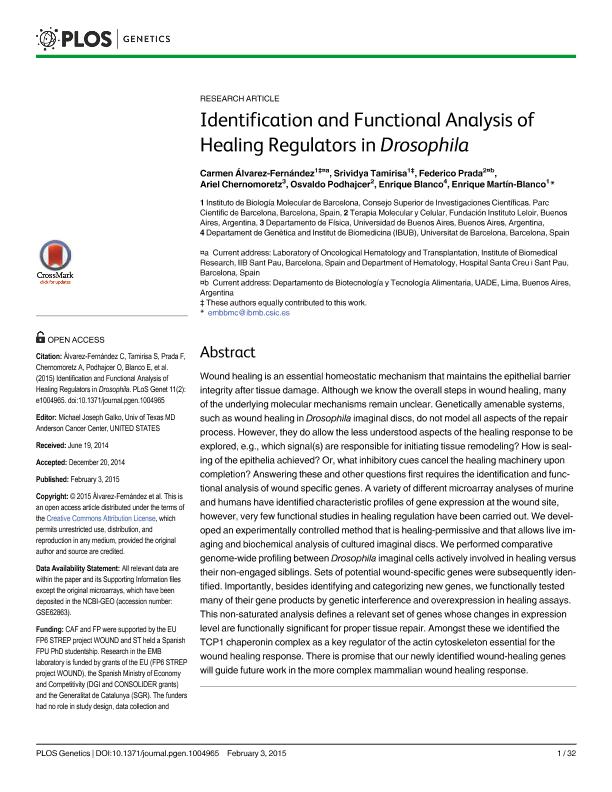Mostrar el registro sencillo del ítem
dc.contributor.author
Álvarez Fernández, Carmen
dc.contributor.author
Tamirisa, Srividya
dc.contributor.author
Prada, Federico
dc.contributor.author
Chernomoretz, Ariel

dc.contributor.author
Podhajcer, Osvaldo Luis

dc.contributor.author
Blanco, Enrique
dc.contributor.author
Martín Blanco, Enrique
dc.date.available
2016-12-27T18:12:34Z
dc.date.issued
2015-02
dc.identifier.citation
Álvarez Fernández, Carmen; Tamirisa, Srividya; Prada, Federico; Chernomoretz, Ariel; Podhajcer, Osvaldo Luis; et al.; Identification and functional analysis of healing regulators in Drosophila; Public Library Of Science; Plos Genetics; 11; 2; 2-2015; e1004965
dc.identifier.issn
1553-7390
dc.identifier.uri
http://hdl.handle.net/11336/10318
dc.description.abstract
Wound healing is an essential homeostatic mechanism that maintains the epithelial barrier integrity after tissue damage. Although we know the overall steps in wound healing, many of the underlying molecular mechanisms remain unclear. Genetically amenable systems, such as wound healing in Drosophila imaginal discs, do not model all aspects of the repair process. However, they do allow the less understood aspects of the healing response to be explored, e.g., which signal(s) are responsible for initiating tissue remodeling? How is sealing of the epithelia achieved? Or, what inhibitory cues cancel the healing machinery upon completion? Answering these and other questions first requires the identification and functional analysis of wound specific genes. A variety of different microarray analyses of murine and humans have identified characteristic profiles of gene expression at the wound site, however, very few functional studies in healing regulation have been carried out. We developed an experimentally controlled method that is healing-permissive and that allows live imaging and biochemical analysis of cultured imaginal discs. We performed comparative genome-wide profiling between Drosophila imaginal cells actively involved in healing versus their non-engaged siblings. Sets of potential wound-specific genes were subsequently identified. Importantly, besides identifying and categorizing new genes, we functionally tested many of their gene products by genetic interference and overexpression in healing assays. This non-saturated analysis defines a relevant set of genes whose changes in expression level are functionally significant for proper tissue repair. Amongst these we identified the TCP1 chaperonin complex as a key regulator of the actin cytoskeleton essential for the wound healing response. There is promise that our newly identified wound-healing genes will guide future work in the more complex mammalian wound healing response.
dc.format
application/pdf
dc.language.iso
eng
dc.publisher
Public Library Of Science

dc.rights
info:eu-repo/semantics/openAccess
dc.rights.uri
https://creativecommons.org/licenses/by/2.5/ar/
dc.subject
Healing
dc.subject
Drosophila
dc.subject
Microarrays
dc.subject
Tcp1
dc.subject.classification
Otros Tópicos Biológicos

dc.subject.classification
Ciencias Biológicas

dc.subject.classification
CIENCIAS NATURALES Y EXACTAS

dc.title
Identification and functional analysis of healing regulators in Drosophila
dc.type
info:eu-repo/semantics/article
dc.type
info:ar-repo/semantics/artículo
dc.type
info:eu-repo/semantics/publishedVersion
dc.date.updated
2016-12-16T17:26:06Z
dc.journal.volume
11
dc.journal.number
2
dc.journal.pagination
e1004965
dc.journal.pais
Estados Unidos

dc.journal.ciudad
San Francisco
dc.description.fil
Fil: Álvarez Fernández, Carmen. Consejo Superior de Investigaciones Cientificas; España
dc.description.fil
Fil: Tamirisa, Srividya. Consejo Superior de Investigaciones Cientificas; España
dc.description.fil
Fil: Prada, Federico. Fundación Instituto Leloir; Argentina
dc.description.fil
Fil: Chernomoretz, Ariel. Universidad de Buenos Aires. Facultad de Ciencias Exactas y Naturales. Departamento de Física; Argentina
dc.description.fil
Fil: Podhajcer, Osvaldo Luis. Fundación Instituto Leloir; Argentina. Consejo Nacional de Investigaciones Científicas y Técnicas. Oficina de Coordinación Administrativa Parque Centenario. Instituto de Investigaciones Bioquimicas de Buenos Aires; Argentina
dc.description.fil
Fil: Blanco, Enrique. Universidad de Barcelona; España
dc.description.fil
Fil: Martín Blanco, Enrique. Consejo Superior de Investigaciones Cientificas; España
dc.journal.title
Plos Genetics

dc.relation.alternativeid
info:eu-repo/semantics/altIdentifier/url/http://journals.plos.org/plosgenetics/article?id=10.1371/journal.pgen.1004965
dc.relation.alternativeid
info:eu-repo/semantics/altIdentifier/doi/http://dx.doi.org/10.1371/journal.pgen.1004965
Archivos asociados
